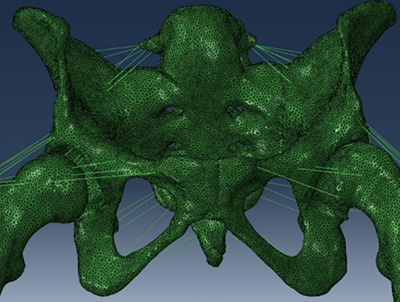Pelvic modelling
Fractures of the pelvis occur due to high-energy impacts (traumatic fractures) and the application of physiologic loads to bone deficient in mineral or elastic resistance (insufficiency fractures). Displaced fractures can lead to disabling post-traumatic arthritis; some fracture patterns induce worse prognosis than others. However, clinical decision-making regarding patient management can be very complex. A better understanding of pelvic and acetabular mechanics and changes in the bone’s mechanical strength could lead to improved diagnosis and treatment of insufficiency and traumatic pelvic and acetabular fractures.
 Specimen specific finite element model of the pelvis.
Specimen specific finite element model of the pelvis.Finite element (FE) analysis is a powerful tool that has been successful in predicting the strength of healthy and pathologic bones. Patient-specific FE modeling is able to represent bones, which are highly heterogeneous in their presentation and are difficult to represent with other analytical or parametrically developed techniques. We have developed and experimentally validated specimen-specific 3D FE models of the pelvis and analyzed them under physiological loading. Using these models, we have examined the sensitivity of pelvic strain to bone material properties, shape difference and loading scenarios.


